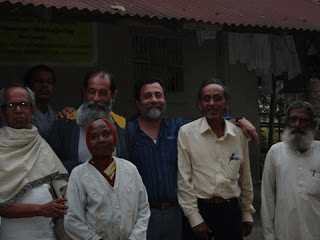First posted November 22, 2015
On November 6, 2015, I visited Naxalbari along with my old comrades, Rabindra Ray (Lalloo), who retired from the Delhi School of Sociology in 2013; and Achintya Barua, (Monju), proprietor of Wild Grass, a tourist resort at the wild life sanctuary in Kaziranga, Assam. Rabindra’s book, The Naxalites and their ideology, was one of the first to be written by an actual participant. We had planned this trip for two years, and were happy that it finally materialised. All three of us, along with many other students from Delhi University (most of us from St Stephen’s College) had joined the Naxalite movement and gone underground in 1970-1971.
NB: Rabindra passed away in 2019. Here’s my tribute to him: DS
It took us some time to locate Kanu Sanyals erstwhile home in Sephtulajote village, Naxalbari, which has been converted into a memorial by his party, CPI (ML) Kanu Sanyal. The village (about 15 km from Bagdogra airport) is a short distance from the main road, and everyone we asked knew whom we were talking about. The path was barely motorable, and what we saw when we arrived was a small thatched building with mud floors and a little courtyard with goats and chickens roaming about. Comrade Subrata welcomed us and we sat for awhile, sipping tea, meeting other old associates of Kanu – some of whom are visible in the photographs below – explaining who we were and why we had come so far to visit Naxalbari. (Naxalbari is a cluster of villages, there seems to be no police or railway station bearing that name).
Kanu was the original ‘Naxalite’, who led a movement of agrarian poor in North Bengal in 1966-67. In April 1967, the Siliguri subdivision in Darjeeling was witness to seizures of land and foodgrain along with attacks on the landed rich. Land Revenue minister Harekrishna Konar tried to placate his ultra-left comrades, but his efforts were futile. On May 24, a police platoon was attacked by several hundred peasants. Inspector Sonam Wangdi was hit by two arrows and died that night. On May 25, the police fired at hostile crowds near PS Khoribari. Ten people, mostly women and children were killed. The Naxalite movement had begun, and was hailed by China as ‘Spring Thunder Over India.’
The CPI(M-L) was inaugurated in 1969. More about the Maoist insurrection in India may be read in my article Permanent Spring, a contribution to Seminar, March 2010. Those interested could also read my novel, Revolution Highway, published in 2010; which has also appeared in Hindi: रिवोल्यूशन हाइवे’
Links to further readings are provided below.
This was a nostalgic trip, to commemorate our friendship which has lasted half a century, and was sealed in revolutionary times. Our ideas about Naxalism have changed, but the friendship remains, along with an indescribable aspiration to human liberation. I cannot speak for others, but my own views have been expressed publicly, over many years.
Be that as it may, there is no doubt that the rebels were motivated by a powerful urge to resist the entrenched system of vested interests who dominated the Indian polity, and still do. If Indian Maoism still exists; and indeed, forces the ruling class to declare it a major security threat, our rulers need to ask themselves how, after seven decades of sovereign power, large areas of the countryside have remained outside the structure of governance, to the point where they could become zones of military insurrection. The central issue has never been poverty and the lack of so-called ‘development’. It has been and remains, the failure of justice, the treatment of millions of Indians as if they were less than human, expendable bio-matter in the machinery of ‘national progress’.
But this is not the place for an analysis of Naxalism. I post these few photographs especially for my dear friends and old comrades. It’s been a long time. Some of us are no longer among the living. Arvind Das, who initiated me into Marxism, died – too young – in 2000. So also did Devapriya (Rana) Sen, in 1985. Ajit Pal, ‘Palda’ passed away in 2007. Some lost their lives in the bloody events of 1970-72.
Comrade Bishen of Birla Cotton Mills, Delhi, is also no more – here is a poem I wrote in his memory: Salaam Comrade





The three of us remembered all of you – at ground zero. Lal salaam!
More posts on Naxalism
An Interview with Kanu Sanyal – Bappaditya Paul, March, 2007
Avijit Ghosh: When I met Kanu Sanyal May 2007
Naxalbari: Home To The Revolution – Sandipan Deb – January 2001
Charu Majumdar and Naxalbari: MARXIST INDIANA
Sumanta Banerjee’s review of THE NAXALITES: THROUGH THE EYES OF THE POLICE
Top Naxal leader Kanu Sanyal found dead in his house
Dilip Simeon: Closing the Circle: On Revolution (Frontier, 2012)
